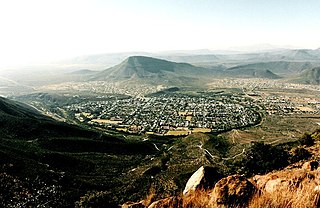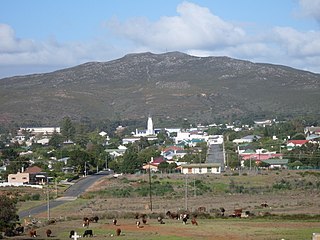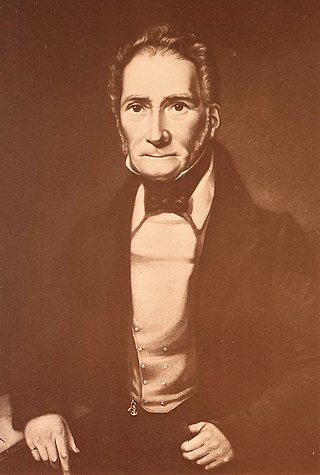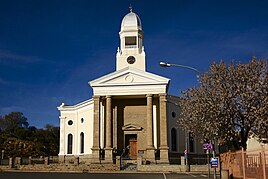
The Merino is a breed or group of breeds of domestic sheep, characterised by very fine soft wool. It was established in Spain near the end of the Middle Ages, and was for several centuries kept as a strict Spanish monopoly; exports of the breed were not allowed, and those who tried risked capital punishment. During the eighteenth century, flocks were sent to the courts of a number of European countries, including France, Hungary, the Netherlands, Prussia, Saxony and Sweden. The Merino subsequently spread to many parts of the world, including South Africa, Australia, and New Zealand. Numerous recognised breeds, strains and variants have developed from the original type; these include, among others, the American Merino and Delaine Merino in the Americas, the Australian Merino, Booroola Merino and Peppin Merino in Oceania, and the Gentile di Puglia, Merinolandschaf and Rambouillet in Europe.

Midrand is a former municipality in central Gauteng, South Africa. Situated in-between Centurion and Sandton, Midrand now forms part of the City of Johannesburg Metropolitan Municipality.

The N1 is a national route in South Africa that runs from Cape Town through Bloemfontein, Johannesburg, Pretoria and Polokwane to Beit Bridge on the border with Zimbabwe. It forms the first section of the famed Cape to Cairo Road.

Graaff-Reinet is a town in the Eastern Cape Province of South Africa. It is the oldest town in the province. It is also the sixth-oldest town in South Africa, after Cape Town, Stellenbosch, Simon's Town, Paarl and Swellendam. The town was the centre of a short-lived republic in the late 18th century. The town was a starting point for Great Trek groups led by Gerrit Maritz and Piet Retief and furnished large numbers of the Voortrekkers in 1835–1842.

Winburg is a small mixed farming town in the Free State province of South Africa.
Lückhoff is a small merino sheep farming town in the Free State province of South Africa. It was established on the farm Koffiekuil in 1892 and named after a Dutch Reformed Church minister Reverend HJ Luckhoff.

Ermelo is the educational, industrial and commercial town of the 7,750 km2 Gert Sibande District Municipality in Mpumalanga province, Republic of South Africa. It is both a mixed agriculture and mining region. It is located 210 km east of Johannesburg.

Middelburg is a large farming and industrial town in the South African province of Mpumalanga.

Hanover is a small town in the Northern Cape Province of South Africa. Named after Hanover in Germany, the town was established in 1854.

Britstown is a small farming town situated in the Northern Cape province of South Africa, in the Pixley ka Seme District Municipality, Emthanjeni Local Municipality. The town is named after Hans Brits who settled here after he accompanied David Livingstone on a venture into the interior.

Nelspoort is a town located in Beaufort West Local Municipality in the Western Cape, South Africa.

Wepener is a town in the Free State, South Africa, located near the border of Lesotho.

Robertson is a town in the Western Cape Province of South Africa, known as the valley of wine and roses, at the heart of the wine route - Route 62.

Sutherland is a town with about 2,841 inhabitants in the Northern Cape province of South Africa. It lies in the western Roggeveld Mountains in the Karoo.

Beaufort West is a town in the Western Cape province in South Africa. It is the largest town in the arid Great Karoo region, and is known as the "Capital of the Karoo". It forms part of the Beaufort West Local Municipality, with 34,085 inhabitants in 2011.

Tarkastad is a Karoo semi-urban settlement situated on the banks Tarka River in the Eastern Cape province of South Africa. Tarkastad is on a plain to the north of the Winterberg mountain range on the R61 between Cradock and Komani and only three hours from Gqeberha. The name Tarkastad is believed to come from the Khoi-Khoi word Traka or the Celtic word Tarka and the Afrikaans word Stad. The fact that the town is overlooked by Martha and Mary; two peaks which look like two women resting after a hard day's work, also lends to the name.

Bredasdorp is a town in the Southern Overberg region of the Western Cape, South Africa, and the main economic and service hub of that region. It lies on the northern edge of the Agulhas Plain, about 160 kilometres (100 mi) south-east of Cape Town and 35 kilometres (22 mi) north of Cape Agulhas, the southernmost tip of Africa.

Middelburg is a town in the Eastern Cape province of South Africa, in the Great Karoo. It lies in the Upper Karoo, 1,279 m above sea level, with a population of 19,000. It falls under the Inxuba Yethemba Local Municipality, in the Chris Hani District Municipality.

Calvinia is a regional town in the Northern Cape province of South Africa named after the French religious reformer Jean Calvin. The town falls under the Hantam Local Municipality which forms part of the Namakwa District Municipality. The Calvinia district is part of the Great Karoo region of South Africa. The town is just south of the Hantam mountains on the banks of the Oorlogskloof River.

Michiel van Breda was a South African farmer, founder of Bredasdorp, Mayor of Cape Town and a Freemason.




























